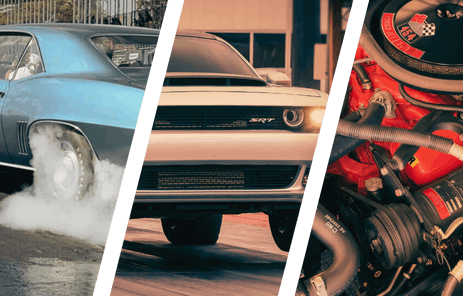

When boys are born, they get blue. When girls are born, they get pink. Simple, right? So what was ‘Ma Mopar thinking when she introduced paint code FM3 in the middle of the 1970 model year for cars that were clearly targeted to red-blooded males? Otherwise known as Panther Pink (Dodge) and Moulin Rouge (Plymouth), they’re among the most desirable of Mopar muscle cars. Any authentic pink Mopar is worth its weight in gold.
Chrysler didn’t invent bright colors or funny names, but the corporation certainly embraced the spirit of psychedelia in 1970 with the following colors:
Color Dodge/Plymouth
FC7 Plum Crazy/In Violet
FJ5 Sublime/Limelight
EK2 Go Mango/Vitamin C (introduced in 1969)
EV2 HEMI Orange/Tor Red (introduced in 1969)
FY1 Top Banana/Lemon Twist
 But on January 28, 1970, the Chrysler Corporation announced two new colors for their High Impact palette: FJ6 and FM3. The former was Green Go/Sassy Grass Green, a bright green somewhat darker than FJ5 that would endure through 1971.
But on January 28, 1970, the Chrysler Corporation announced two new colors for their High Impact palette: FJ6 and FM3. The former was Green Go/Sassy Grass Green, a bright green somewhat darker than FJ5 that would endure through 1971.
But FM3 was a retina-burning magenta that only lasted through the 1970 model year. Authentic FM3 cars are very rare, which is why this 1970 Super Bee on eBay caught my eye.
This ‘Bee is typical of the ‘Bees built in 1970: 383 Magnum, automatic, C-stripe, and standard hood. Air conditioning is one of the less common options for a ‘Bee. But being a real FM3 Super Bee makes it one of 32 hardtops built (US-specs, not Canadian or export); an additional 7 coupes (with the B-pillar) were built too.
The color has so much notoriety in the Mopar world that Chrysler released a Millennium version of the color named Furious Fuchsia for 2010 Challengers. More of a raspberry than a magenta, plenty of chest-thumping men lined up to snap up one of Mopardom’s most famous tints.
You might also like
SEMA 2025: Superformance Godzilla Cobra Snake Packs 1,000 HP
The Godzilla Cobra is a 1,000hp tribute to Carroll Shelby. Superformance's new CSX10000 features a supercharged 7.3L V8.



